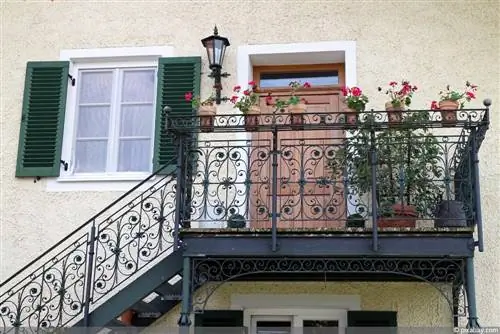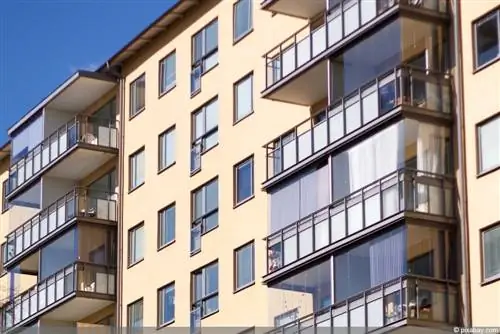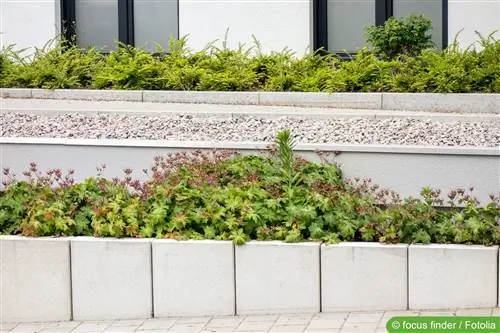- Author admin [email protected].
- Public 2023-12-17 03:39.
- Last modified 2025-06-01 06:48.
Enjoy the sun or create an outdoor area for plants - with an extension balcony this is possible even if the apartment or home does not yet have a balcony. However, numerous factors must be taken into account before installation. Selection, building permits and, last but not least, the costs of the kit must be taken into account. There are significant differences here.
Growing balcony types
There are different types of extension balconies, which are differentiated based on how they are attached to the house wall. These include:
Self-supporting balconies
Balconies of this type stand on four supports and are simply attached to the wall of the house to prevent them from falling over. This makes assembly very easy. Structural changes are hardly necessary. It is also possible, at least partially, to build the balcony yourself with the appropriate kit. Such imaginary balconies can also be easily covered and have greater construction depths.
Partially self-supporting balconies
These extension balconies have two supports. The fixation to the house must therefore be more stable and resilient. This means more effort and therefore the need for more structural changes. Depending on the nature of the house wall, the balcony depths must be limited to ensure stability.
Balconies without supports
The balcony is supported directly by the house wall and therefore, depending on its condition, may not exceed a certain depth. This variant is therefore not suitable for some house walls. The effort required for structural changes is comparatively high, as not only must the balcony be securely fixed, but attention must also be paid to the insulation.
Which type of balcony you choose does not just depend on your personal preference. The decisive factors are, above all, whether the required load capacity is present and how much space is available. For example, if you want to build as large a balcony as possible, you should avoid a kit without supports. However, extension balconies with two supports could be an option. Also a projection balcony that is self-supporting.
Building permit
Before the installation of the extension balcony can be started, information about the building permit must first be obtained. Not every balcony requires approval. However, in order to avoid problems later, the responsible building authority should be consulted in advance. The decisive factors here are, among other things, the dimensions of the balcony as well as the distance to public sidewalks and the property line. However, the regulations vary from state to state, so no general statements can be made. The same applies to the costs incurred when applying for a building permit. However, you have to expect 400 to 500 euros if official permission is required.
Tip:
In order to avoid possible difficulties, permission should also be obtained from the neighbors in writing if they could be affected in any way by the extension balcony.
Material
Add-on balconies are usually made of wood, steel, aluminum or even concrete. Every material has certain advantages and disadvantages:
Wood
The weight and cost of the wood can vary greatly depending on the type. The assembly is extremely simple, so that with softer woods you can even carry out some of the construction steps yourself. However, maintenance and sealing result in follow-up costs.
Steel
A steel extension balcony is about mid-range in terms of price. The situation is similar with weight. Steel is lighter than concrete, but heavier than wood. This makes it difficult to build the balcony yourself if possible. In addition, follow-up costs must be expected if there are rusty areas.
Aluminium
The material is light but durable. Installation is easy and usually cheaper, especially due to the low weight. However, aluminum is more expensive to purchase.
Concrete
It is very cheap to buy but also very heavy. The weight may increase the cost of assembly. However, concrete is easy to maintain and there are no ongoing costs.
Kit

There are significant differences in the kits for extension balconies. Both in terms of design and price.
The price is determined by:
- the size and type of balcony
- whether a railing is included
- the material
- whether building permits and static calculations are taken over by the provider or seller
- whether assembly is already included
- whether a roof is included
Even with small dimensions, you have to expect a price of 2,000 to 4,000 euros and more for an extension balcony or the balcony kit alone. These costs apply for a balcony depth of 1.5 meters and a width of 2.0 meters. For larger versions with depths over 1.5 meters and widths over 3.0 meters, it can even be used with over 10.000 euros can be calculated. Of course, the material and additional equipment, such as gutters or the possibility of installing a flight of stairs, also play a role here.
Tip:
Simple kits for imaginary balconies are usually significantly cheaper in comparison.
Total costs
The construction costs for an extension balcony are usually made up of the following factors:
- Permit for the construction of the balcony - approx. 500 euros
- Static calculations - approx. 500 euros
- Balcony kit with railing - approx. 2,000 to 4,000 euros
- Assembly - approx. 2,000 euros
- Wall breakthrough, installation of the balcony door and balcony door - 2,000 euros
- Thermal insulation and prevention of cold bridges - from 1,000 euros
Even in this example with a rather small balcony, the purchase and installation costs can be up to 10.000 euros. It should of course be taken into account that approval, as well as thermal insulation and prevention of cold bridges, are not required in every case. The price can therefore vary depending on the work steps required. For example, you can find cheaper kits, taking on individual parts of the assembly yourself or building the balcony yourself can reduce costs and the choice of material also has a decisive influence on the overall price.
It should be noted, however, that it is rarely advisable to build the balcony completely yourself. On the one hand, safety should always be a priority. On the other hand, self-construction requires static and stability checks, which are also subject to a fee. However, what is usually possible with the appropriate knowledge and craftsmanship experience is to install the railing yourself. If the railing is made of wood, you can also seal it yourself. Of course, you have to consider whether the price for railings and varnish or stain is lower than that of an already sealed railing.






